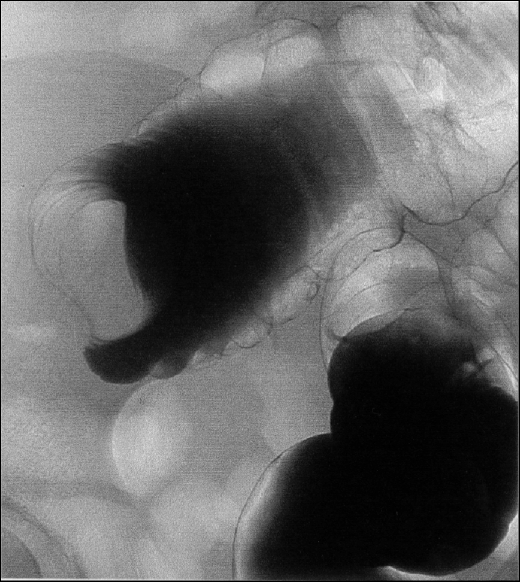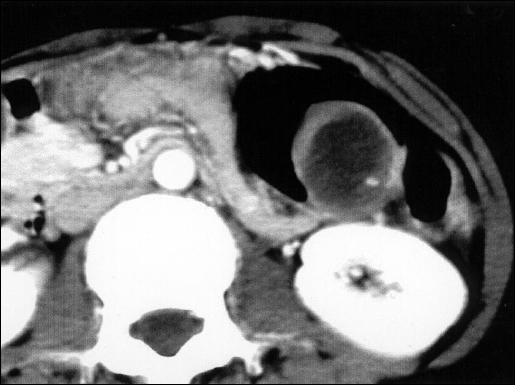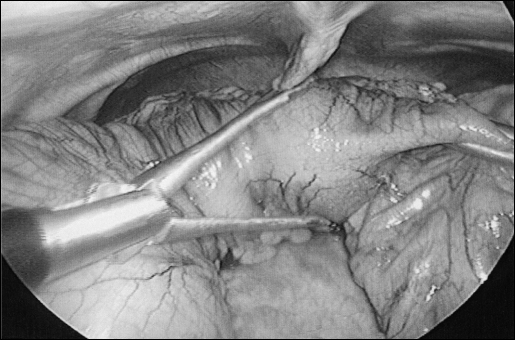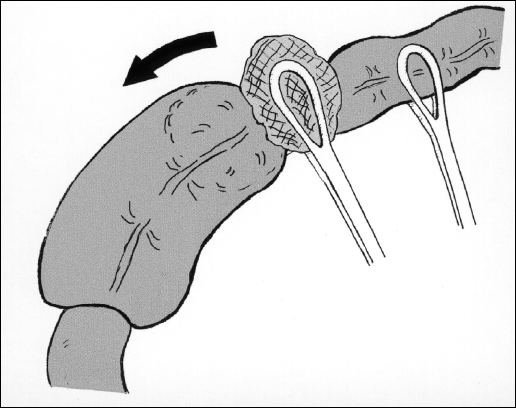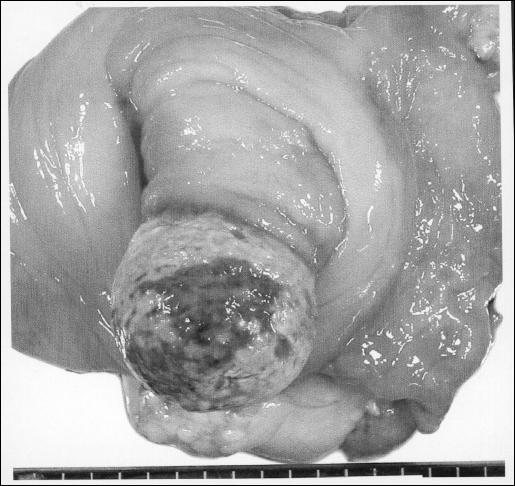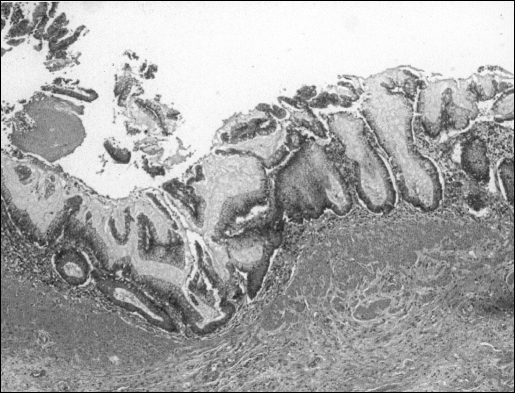Abstract
Objective:
Laparoscopic reduction of appendicocecal intussusception due to mucinous cystadenoma is herein described.
Methods:
A 32-year-old female had intermittent abdominal pain and nonbloody diarrhea. The preoperative diagnosis was intussusception of the colon with a benign tumor by CT-scan findings.
Results:
Laparoscopic reduction of intussusception and ileocecal resection were successfully performed. Gauze sponge sticks were used to provide compression from the distal colon. This maneuver was very effective to reduce the intussusception.
Conclusion:
Laparoscopic reduction of intussusception due to a benign tumor is feasible and safe even in adults. Mucinous cystadenoma is one of the causes of intussusception in adults and a good indication for the laparoscopic approach.
Keywords: Laparoscopic surgery, Intussusception, Mucinous cystadenoma
INTRODUCTION
Intussusception in adults is rare and generally requires surgical treatment. Few reports of laparoscopic treatment of this condition exist.1 This report describes an adult case of intussusception due to mucinous cystadenoma of the appendix treated laparoscopically.
CASE REPORT
A 32-year-old female had intermittent abdominal pain and nonbloody diarrhea for 20 days. She had 3 previous Caesarean deliveries. The family history was unremarkable. Laboratory data were normal. The abdominal x-ray showed a radiopaque mass near the splenic flexure. A colonoscopy revealed intussusception at the transverse colon. A biopsy only yielded necrotic tissue. A barium enema showed a crab's claw sign at the mid transverse colon (Figure 1). A computed tomography (CT) scan showed a 3-cm, clear, low-density area in the transverse colon (Figure 2). The preoperative diagnosis was intussusception of the colon with a benign tumor.
Figure 1.
Barium enema showed filling defect with crab's claw sign at the mid transverse colon.
Figure 2.
Enhanced computed tomography showed well-encapsulated, low-density area in the transverse colon.
Laparoscopic assessment was undertaken with 5-port access. After adhesiolysis between the major omentum and the abdominal wall caused by the previous Caesarean deliveries, the intussusception was confirmed at the middle of the transverse colon. Reduction was attempted unsuccessfully with 2 large grasping instruments (Figure 3). Next, gauze sponge sticks with these instruments were used to provide compression from the distal colon (Figures 4 and 5). This maneuver was very effective. The intussusception was reduced and almost released. After laparoscopic mobilization of the right colon, the ileocecal portion was pulled out through a 5-cm longitudinal skin incision. Ileocecal resection was accomplished, and end-to-end anastomosis was performed extracorporeally. The postoperative course was uneventful, and the patient was discharged on the ninth postoperative day.
Figure 3.
Laparoscopic reduction of the intussusception was unsuccessful with hard grasper.
Figure 4.
Laparoscopic reduction with gauze sponge stick was effective.
Figure 5.
Schema of laparoscopic gentle reduction of the intussusception.
A 3-cm tumor was located in the appendix and invagination into the cecum was seen (Figure 6). The histological diagnosis was mucinous cystadenoma (Figure 7).
Figure 6.
The diameter of the appendix tumor was 3.0 cm. The tumor was filled with mucus.
Figure 7.
Histological diagnosis was mucinous cystadenoma.
DISCUSSION
Intussusception in adults is rare. Table 1 shows the causes of adult intussusception in 400 cases from Japanese domestic reports. Common causes in excess of 10% included cancer, lipoma, small bowel tumor, and lymphoma. Mucinous cystadenoma of the appendix accounted for 3.3% of intussusception in adults. Only 13 cases have been reported in Japanese in the past 10 years. A few reports have also been published in English.2–5 A preoperative diagnosis of intussusception is sometimes difficult. However, the CT scan in this case revealed a well-encapsulated cystic lesion forming the lead point of the intussusception. It is possible to diagnose mucinous cystadenoma from its characteristic appearance as a well-defined, homogeneous low-density mass.6
Table 1.
Causes of Intussusception in Adults From Japanese Reports (1991-2000).
| Disease | No. | Rate(%) |
|---|---|---|
| Cancer | 98 | 24.5 |
| Lipoma (ileum, colon) | 53 | 13.3 |
| Small bowel tumor | 49 | 12.3 |
| Lymphoma (ileocecal) | 45 | 11.3 |
| Meckel's diverticulum | 24 | 6.0 |
| Mucinous cystadenoma of the appendix | 13 | 3.3 |
| Other large bowel tumor | 3 | 0.8 |
| Ileus tube | 24 | 6.0 |
| Idiopathic | 32 | 8.0 |
| Others (eg, postoperative) | 59 | 14.8 |
Mucinous cystadenoma is a benign disease. Complete resection of the tumor is sufficient treatment. In this process, we must avoid tumor rupture as some of these mucoceles could be mucinous cystadenocarcinoma, which can cause pseudomyxoma peritonei.7 If a tumor indicates the possibility of carcinoma, the mesenteric resection should encompass lymph node clearance.
The laparoscopic approach to intussusception has been mostly reported in children.8, 9 Laparoscopic reduction was successful in 50% to 65% of these reported cases. Only one report4 exists of laparoscopic ileocolic resection for intussusception caused by mucinous cystadenoma of the appendix. In the textbook description, reduction is achieved by gently squeezing the mass from the distal side to reduce the intussusception rather than by pulling the ileum, which will cause tearing.10 We tried this maneuver laparoscopically by using a gauze sponge, which was atraumatic and proved very effective for the reduction of intussusception. In our opinion, laparoscopic reduction of intussusception is feasible even in adults; however, it should be performed for benign disease. Therefore, mucinous cystadenoma and lipoma causing intussusception are good indications for laparoscopic colectomy.
References:
- 1. Park KT, Kim SH, Song TJ, Moon HY. Laparoscopic-assisted resection of ileal lipoma causing ileo-colic intussusception. J Korean Med Sci. 2001;16:119–122 [DOI] [PMC free article] [PubMed] [Google Scholar]
- 2. Gockel I, Kupczyk-Joeris D, Gaedertz C, Peters H. Invagination of the vermiform appendix in mucinous cystadenoma [in German]. Chirurg. 1998;69(5):571–573 [DOI] [PubMed] [Google Scholar]
- 3. Jones CD, Eller DJ, Coates TL. Mucinous cystadenoma of the appendix causing intussusception in an adult. Am J Gastroenterol. 1997;92:898–899 [PubMed] [Google Scholar]
- 4. Heithold DL, Tucker JG, Lucas GW. Appendiceal intussusception as a manifestation of mucinous cystadenoma of the appendix: an interesting clinical entity. Am Surg. 1997;63:390–391 [PubMed] [Google Scholar]
- 5. Chetty R, Daniel WJ. Mucinous cystadenoma of the appendix: an unusual cause of recurrent intussusception in an adult. Aust N Z Surg. 1992;62:670–671 [DOI] [PubMed] [Google Scholar]
- 6. Kim SH, Lim HK, Lee WJ, Lim JH, Byun JY. Mucocele of the appendix: ultrasonographic and CT findings. Abdom Imaging. 1998;23:292–296 [DOI] [PubMed] [Google Scholar]
- 7. Holder PD, Fehir KM, Schwartz MR, Smigocki G, Madewell JE. Primary mucinous cystadenocarcinoma of the appendix with pseudomyxoma peritonei manifested as a splenic mass. South Med J. 1989;82:1029–1031 [DOI] [PubMed] [Google Scholar]
- 8. Schier F. Experience with laparoscopy in the treatment of intussusception. J Pediatr Surg. 1997;32:1713–1714 [DOI] [PubMed] [Google Scholar]
- 9. Poddoubnyi IV, Dronov AF, Blinnikov OI, Smirnov AN, Darenkov IA, Dedov KA. Laparoscopy in the treatment of intussusception in children. J Pediatr Surg. 1998;33:1194–1197 [DOI] [PubMed] [Google Scholar]
- 10. Morris PJ, Malt RA. Oxford Textbook of Surgery. New York, NY: Oxford University Press Inc; 1994:2042 [Google Scholar]



